GETTING TO THE ROOT OF GARDENING
/2 Comments/in Design, Flowers, Fruit, Gardening/by Lee ReichEtymological Wanderings
Sure, I’ve been dropping seeds into mini-furrows in some seed flats, and prunings are starting to litter the ground outdoors. But there’s a lot of nongardening activity going on here. What better time to ponder etymology? (Etymology, not entomology, the latter of which is the study of insects; aphids, mealybugs and whiteflies, all of which will be crawling around soon enough.) What exactly do we mean when we talk about a “garden” or “gardening?”

Garden(?) in Italy
The word “gardening” is pretty much synonymous with “horticulture,” which comes from the Latin hortus meaning a garden, and cultura, to culture. According to Webster, horticulture is the “art or science of cultivating fruits, flowers, and vegetables.” The word “horticulture” was given official recognition in The New World of English Words in 1678 by E. Phillips, although though the Latin form, horticultura, first appeared as the title of a treatise of 1631.
Horticulture, then, is about growing fruits, flowers, and vegetables; nothing is said about cultivating a field of cotton or wheat. These latter crops are in the ken of agronomy, from the Latin root ager meaning field. Once again quoting Webster, agronomy is the “science or art of crop production; the management of farm land.” Horticultural crops are more intensively cultivated than farm crops — and more apt to be threatened by neglect.
In fact, “gardening” and “horticulture” are not exactly synonymous. Horticulture is usually associated with growing plants for a livelihood, and is broken down into pomology (fruits), olericulture (vegetables), floriculture (flowers) and landscaping. Gardening usually implies something more homey and intimate.
Gardyne Styles
Over the centuries, the word “garden” has been penned in many spellings. A chronicler of the 13th century wrote “gardynes,” in the next century Chaucer wrote the word a bit differently: “Yif me a plante of thilke blessed tre And in my gardyn planted it shall be.” We see yet another spelling early in the sixteenth century: “My lord you have very good strawberries at your gardayne in Holberne.” Finally, by the time of Shakespeare, we have: “Ile fetch a turne about the Garden.” Here, “garden” at least, is spelt [sic] the moderne [sic] way.
The root of the word “garden” comes from the Old English geard, meaning fence, enclosure, or courtyard, and the Old Saxon gyrdan, meaning to enclose or gird.
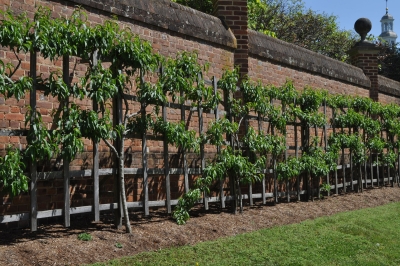
Walled garden
These words are closely related to our modern words “yard,” “girth,” and “guard.” Medieval gardens were physically enclosed. My vegetable garden is too, but mostly as protection against rabbits that love my peas and beans, not against knights practicing their jousting or wild pigs roaming the fields. The medieval garden was against the house and protected by a high wall, or, perhaps a wattle fence.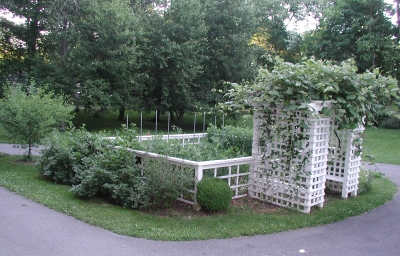
Over the centuries, “garden” and “gardening” have come to mean more than the fenced medieval garden. The archetypal Persian garden is dominated by refreshing pools or fountains of water. In the Italian garden, we find trees and shrubs, and stone stairways, balustrades, and porticos.

Classic Italian garden
Grand parterres characterize the French style of gardening.

Parterres in French garden
About a hundred years ago, the increasingly grand style of gardening fell from favor as an Englishwoman, Gertrude Jekyll, came forward to laud and design gardens that emulated intimate, colorful, and informal cottage gardens. She wrote that the ” . . . first purpose of a garden is to give happiness and repose of mind, which is more often enjoyed in the contemplation of the homely border . . . than in any of the great gardens where the flowers lose their identity, and with it their hold on the human heart.”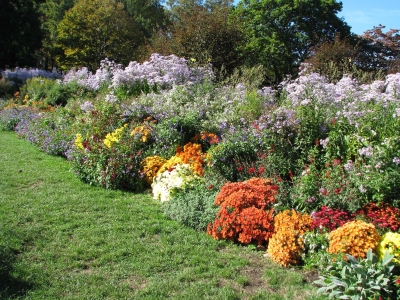
And Today . . . ?
What does “garden” and “gardening” mean today? A few tomato and marigold plants, separated from the dwelling by an expanse of lawn? A woodland glen of ferns and bleeding hearts? More recently, “forest gardens” have incorporated edible plants in forest-ish settings.

A forest garden?
How about a knot garden of herbs within a white picket fence — in the medieval style, one might say?
The World Was My Garden, the title of the book by early 20th century plant explorer and botanist David Fairchild offers another perspective on “garden.” (I’ll change the “was” to “is,” though.) I’m not sure where my garden ends and whatever else grows within my property boundaries begins.
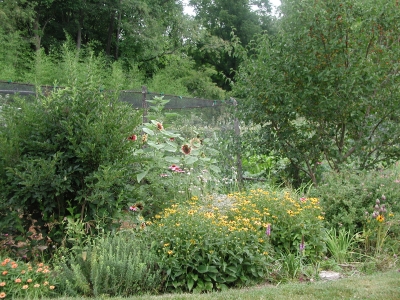
What’s the boundary of this garden?
I pick strawberries in my vegetable garden and grow Caucasian mountain spinach among my gooseberries. Grapevines clamber on the arbor over my terrace, and a stewartia tree, mountain laurels, and lowbush blueberries snuggle near the east side of my home.
And why stop at property boundaries?

Mountains “in” this garden

Buildings as part of this garden, NYC HIghline
A row of eighty foot tall pine trees peer over the tops of my pear trees from the far end of my neighbor’s property two houses away to the north.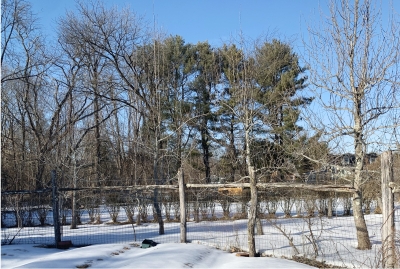 To the south my meadow ends at a sweep of another neighbor’s field, the more frequently mown grass of which undulate like waves in summer sunshine in contrast to the more upright asters, fleabanes, goldenrods, and monardas that stand upright among the grasses in my meadow.
To the south my meadow ends at a sweep of another neighbor’s field, the more frequently mown grass of which undulate like waves in summer sunshine in contrast to the more upright asters, fleabanes, goldenrods, and monardas that stand upright among the grasses in my meadow. 
Further extending the boundary are gardens revisited in my memory and those I have yet to see.

My boundless garden
FIGS: WAIT, DON’T GROW!
/17 Comments/in Gardening/by Lee ReichStay Asleep Please
If you garden in a cold winter climate, as do I, I hope you’re growing figs. Despite being tropical plants, figs are relatively easy for us to grow, as attested to by other gardeners, from Moscow to Montreal, Minneapolis and beyond.

San Piero fig, ripe
If you garden in a cold winter climate, I also hope that your fig plant is NOT growing now (unless you’re in the Southern Hemisphere). The way we cold-climate fig growers help our plants face winter cold is by protecting them from it. A usual method is to grow a plant in a pot that gets moved to a sheltered location to wait out winter. (Growing in pots plus four other methods of overwintering figs are described in my recent book Growing Figs in Cold Climates.)
Sometimes — too often — a fig jumps the gun on spring and starts growing in its sheltered location. Figs shed their leaves when they feel cold is just around the corner, so don’t need bright light in winter. But once buds awaken, they need all the light it can get.
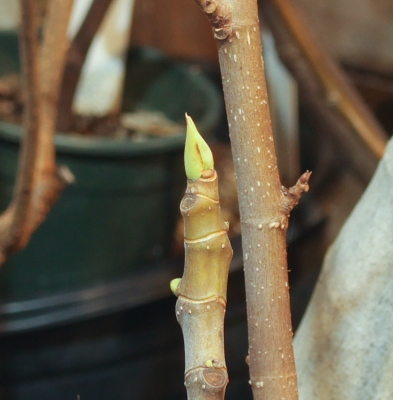
Fig starting to wake up
Don’t fool yourself that a sunny window is sufficient light. The light there typically ranges from 2,000 to 5,000 foot-candles, while full sunlight outdoors is over 10,000 foot-candles. With insufficient light, growth becomes etiolated, that is, stretched out and pale as if reaching for light. And when the time comes for the plant to move outdoors, strong sunlight and drying winds will burn those etiolated stems.
Sleep Recipes
So the goal is to retard growth until outdoor conditions are more fig-friendly. If fully dormant, the plant can tolerate temperatures down into the low 20s Fahrenheit, even colder in a large enough pot. (Cold penetrates more deeply into smaller pots, and fig roots, like those of all temperate-zone plants, can’t tolerate as much cold as stems.)
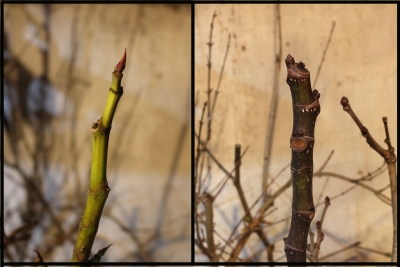
Fig stems, dormant
The ideal situation is to be able to move a fully dormant fig plant outdoors while temperatures are still cold, but not cold enough to injure the stems or roots. Then buds gradually unfurl in synch with warming temperatures and increasingly intense sunlight.
My potted plants are fully dormant, the result, all winter, of keeping the pots in a cold room with minimal watering. Ideal winter temperatures for a fig are between the high 20s and low 40s. A barely or unheated garage, a cold basement, an unheated mudroom or attic, perhaps even a shed can all keep a fig asleep long enough.
Most of my plants get watered just once in winter. I lift the pots and can tell by experience from their weight whether water is needed. A soil moisture meter probe also works. They are in humid locations, either in my basement or in a walk-in cooler. Sealing each pot and soil, not the stems, in a plastic bag could cut down or eliminate any need for water.
Only one of my potted figs has already started growing. (I let it do so for this photograph.) My one growing fig is actually doing quite well, with new growth expanding slowly and robustly.  Besides having its thirst quenched just enough to prevent wilting, it sits in front of a large, unobstructed window facing due south in a room whose temperatures range from the 50s and 60s. (That’s why I’m writing while sitting here in a down jacket!)
Besides having its thirst quenched just enough to prevent wilting, it sits in front of a large, unobstructed window facing due south in a room whose temperatures range from the 50s and 60s. (That’s why I’m writing while sitting here in a down jacket!)
Shock Treatment
Okay, so you can’t provide ideal enough conditions, and your plant is overenthusiastic about winter’s end. Give it a little shock. Potted figs do need repotting every year or two to refresh soil nutrients and give roots new room to grow. If the plant is in as large a pot as you wish, the root ball needs to be slid out of the pots and sliced back to afford space for fresh potting soil. The larger the plant, the more roots can be removed. I go around the edge of the root ball with a kitchen knife slicing an inch or two off around the edge of the root ball. That should tell Ms. Fig to chillax!
The larger the plant, the more roots can be removed. I go around the edge of the root ball with a kitchen knife slicing an inch or two off around the edge of the root ball. That should tell Ms. Fig to chillax!
Stem pruning is another way to put the brakes on growth. And figs anyway benefit from annual pruning. How much to prune depends on the bearing habit of the fig, some varieties bearing best on new growth, some on one-year-old growth, and still others on both types of growth. (I refer you to my book for details about pruning figs.)
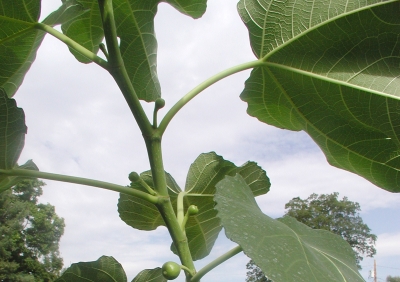
Fig fruits developing on new growth
Not to Worry
Perhaps you haven’t provided ideal winter conditions, you have no sun drenched windows, your home is warm, and you already repotted and pruned last fall. Don’t give up. Worst case scenario is that sappy, etiolated stems have emerged on your fig plant. Once outdoor temperatures moderate, you have three choices.
Gradually acclimate the plant to the great outdoors in much the same way as is done with tomato seedlings. Start the plant with a week or so in an outdoor location protected from full sunlight, wind, and freezing temperatures, moving it periodically indoors if conditions make it necessary. Gradually move it to the more exposed location of its summer home.
Second choice. Move the plant immediately to its summer home, but prune back growing stems, which, anyway, will likely burn.
Third, and easiest, choice, is to move the plant immediately to its summer home. Period. You’ll see some dieback and burning, but the plant should survive unless it’s very young or very weak.
The nice thing about growing figs, and one of the thinks that makes it possible to grow them in cold climates, is that they are very forgiving plants. More so than you might imagine.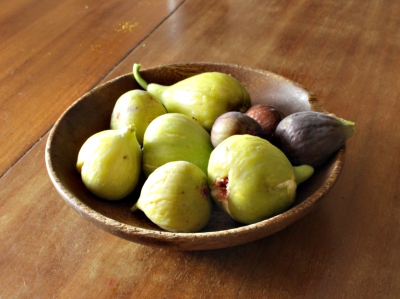
OMINOUS HOUSEPLANTS
/6 Comments/in Houseplants/by Lee ReichPoinsettia Absolved
Sunny temperature reaching the 50s a few days ago enticed me outdoors for pruning. Today, with temperatures in the 20s, I’m back indoors (except for a very pleasant cross-country ski tour earlier) looking over what plants I have, or might have, growing indoors. Their ominous or not so ominous sides.
Mention poisonous houseplants and most people immediately think of poinsettias. Actually, poinsettia’s bad reputation is unfounded. The plant’s not really poisonous. Only a masochist would be able to ingest enough of this foul tasting plant to cause the occasional cases of vomitting that have been reported. This is not to pooh-pooh the toxicity of all houseplants. Many are poisonous.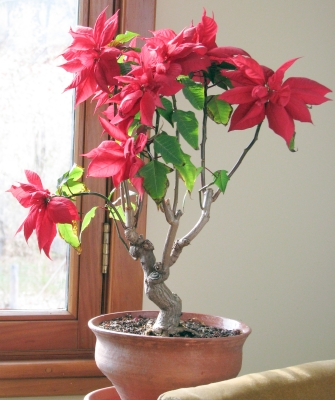
No sane adult walks around the house plucking houseplant leaves to eat; the greatest danger from poisoning is to children. Ten percent of the inquiries to poison control centers across the nation concern plant poisonings, and the bulk of those inquiries concern children younger than three years. (But in only a small percentage of these cases does the child actually have symptoms of poisonings.)
Common Culprits
Years ago, I hosted philodendron and dumbcane (Diffenbachia spp.), two very common houseplants, in my home. These two plants are responsible for the first and second most reported poisonings, respectively.
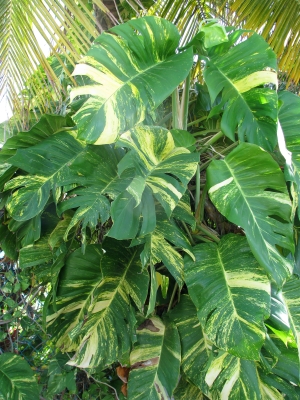
Variegated philodendron
They are in the Araceae Family, a group of plants with needle-like crystals of calcium oxalate in their leaves and stems. When chewed, the crystals cause immediate pain in the mouth and throat, which commonly leads to swelling. This makes speech difficult and is the origin for the common name “dumbcane” for Diffenbachia species. Ingest enough leaves of either plant and vomiting and diarrhea, even death, could follow. Other houseplants in this family include elephant’s ear (Alocasia spp.), flamingo flower (Anthurium spp.), and caladium (Caladium bicolor).
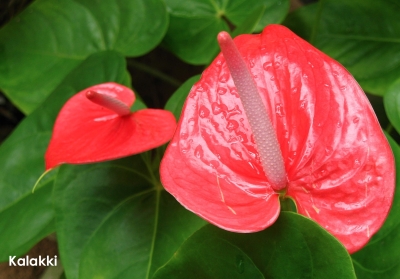
Anthurium
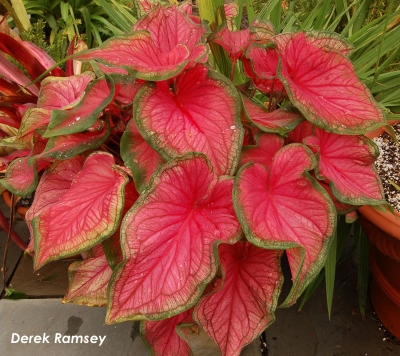
Caladium
The “philodendron” that I grew and many people grow is commonly known as Swiss cheese plant, for its large, holey leaves. Botanically, it’s not a Philodendron, although it was originally classified as one. Now it’s botanical name is Monstera deliciosa. Deliciosa! A poisonous plant? This is one member of the Araceae that bears an edible fruit. The fruit resembles an ear of corn and tastes something like a combination of pineapple and banana. That’s when it’s ripe. Unripe, not so tasty, rich in oxalic acid, and poisonous.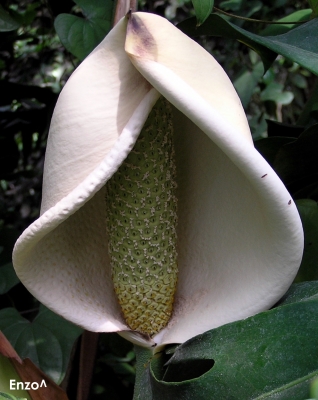
Poinsettias are ranked third as far as the number of reported (not actual) poisonings nationwide. Although poinsettia really is not toxic, it’s a member of the Spurge Family, a family which includes many toxic plants. Guilt by association, perhaps. Members of the Spurge Family contain a milky latex in their sap, and this latex can cause dermatitis. A houseplant Spurge that does warrant caution is the Crown-of-Thorns, which, as long as we are talking about danger to children, also is heavily armed with stout thorns.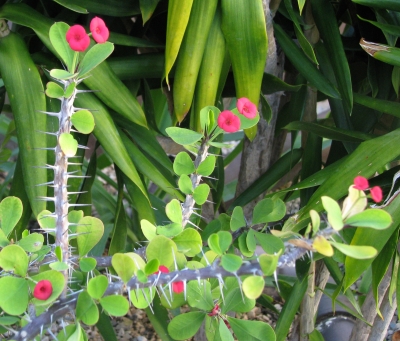
Now is the time of year when blooms on forced bulbs carry gardeners through the last leg of winter before spring planting. Most of these bulbs are in the Lily Family,
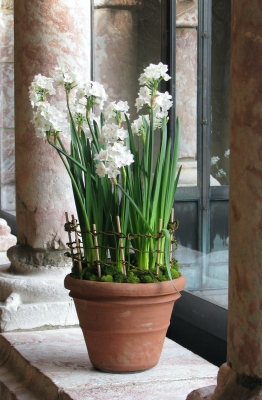
another family with many poisonous members. The daintiness of Lily-of-the-Valley belies the fact that it contains a potent cardiac glycoside (much like the digitalis found in foxgloves), which even leaches into the water of cut flowers. Hyacinths are wonderfully fragrant, yet also toxic. All parts of sunny daffodils contain lycorine, a toxin that can cause dermatitis with skin contact, and diarrhea and convulsions if ingested.
That toxin, lycorine, also is found in another winter bulb, amaryllis (Hippeastrum spp.), though amaryllis is not in the Lily Family.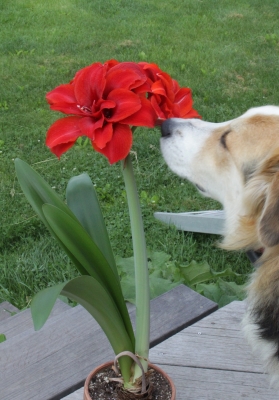
And More
A few other houseplants in widely scattered plant families also are worth mentioning for their toxicity. Jerusalem cherry (Solanum pseudocapsicum), a houseplant with brightly colored berries, is in the Deadly Nightshade Family. The family name should tell you something about the plant’s toxic properties. Not all members of the family are toxic in the amounts normally ingested; if so, we’d have to give up eating tomatoes, eggplants, peppers, and potatoes.
Mistletoe is not a houseplant per se, yet it is a plant in the house at Christmas. The white berries, which tend to fall to the ground as the plants dry out, are toxic.
English ivy is a plant that is grown both indoors and outdoors. Unfortunately, its leaves are also toxic.
I don’t like to cast a somber cloud over these houseplants, but it’s important to know which are toxic so as to keep them beyond the inquisitive reach of very young hands. If a child does manage to ingest a plant, save part of the plant for positive identification, and then call a poison control center (http://www.aapcc.org/DNN/). It is not always advisable to induce vomiting, because this can further spread irritating materials.
Now why does an otherwise friendly looking plant — a philodendron, for instance — have to strike a menacing chord with a toxin in its leaves? Inside our homes, overwatering or underwatering probably is the major threat to any houseplant’s existence. But out in the jungle, a philodendron needs some way to ward off a big gorilla who might find the leaves an appetizing salad. In this case, a burning, swollen mouth is a good deterrent.

